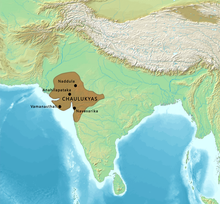
Back سلالة تشولوكيا Arabic চৌলুক্য রাজবংশ Bengali/Bangla Dinastia Solanki Catalan Solanki German Dinastía Chaulukya Spanish سلسله چاولوکیا FA Solankî French સોલંકી વંશ GU सोलंकी वंश HI チャウルキヤ朝 Japanese
| Chaulukya Solanki | |
|---|---|
 A Chaulukya coin, circa 950-1050. Stylized rendition of Chavda dynasty coins: Obverse: Indo-Sassanian style bust; pellets and ornaments around. Reverse: Stylised fire altar; pellets around.[1] | |
 Map of the Chaulukya dynasty c. 1150 CE, according to Joseph E. Schwartzberg, [2] | |
| Parent house | Chavda dynasty |
| Country | |
| Founded | 941 |
| Founder | Mularaja |
| Final ruler | Tribhuvanapala |
| Seat | Anahilavada |
| Cadet branches | Vaghela dynasty |
The Chaulukya dynasty (IAST: Caulukya), also Solanki dynasty, was a dynasty that ruled the Kingdom of Gujarat in western India, between c. 940 CE and c. 1244 CE. Their capital was located at Anahilavada (modern Patan). At times, their rule extended to the Malwa region in present-day Madhya Pradesh. The family is also known as the "Solanki dynasty" in the vernacular literature. They belonged to the Solanki clan of Rajputs.[3][4][5]
Mularaja, the founder of the dynasty, supplanted the last ruler of the Chavda dynasty around 940 CE. His successors fought several battles with the neighbouring rulers such as the Chudasamas, the Paramaras and the Chahamanas of Shakambhari. During the reign of Bhima I, the Ghaznavid ruler Mahmud invaded the kingdom and raided the Somnath temple during 1024-1025 CE. The Chaulukyas soon recovered, and the kingdom reached its zenith under the rule of Jayasimha Siddharaja and Kumarapala in the 12th century. Several minor dynasties, such as the Chahamanas of Jalor and the Chahamanas of Naddula, served as Chaulukya vassals during this period. After Kumarapala's death, the kingdom was gradually weakened by internal rebellions; uprisings by feudatories; and invasions by the Paramaras, the Ghurids, the Yadavas and others. Taking advantage of this, the Vaghelas, who had earlier served as Chaulukya generals, usurped the power and established a new dynasty in the 1240s.
Several princely state rulers of the Solanki clan claimed descent from the Chaulukyas.
- ^ Post-Gupta (Chaulukya-Paramara) coin, Classical Numismatic Group.
- ^ Schwartzberg Atlas,p.148
- ^ Hermann Kulke (2004). A History of India. Psychology Press. p. 117. ISBN 978-0-415-32919-4.
When Gurjara Pratiharas power declined after the sacking of Kannauj by the Rashtrakutkas in the early tenth century many Rajput princes declared their independence and founded their own kingdoms, some of which grew to importance in the subsequent two centuries. The better known among these dynasties were the Chaulukyas or Solankis of Kathiawar and Gujarat, the Chahamanas (i.e. Chauhan) of eastern Rajasthan (Ajmer and Jodhpur), and the Tomaras who had founded Delhi (Dhillika) in 736 but had then been displaced by the Chauhans in the twelfth century.
- ^ Brajadulal Chattopadhyaya (2006). Studying Early India: Archaeology, Texts and Historical Issues. Anthem. p. 116. ISBN 978-1-84331-132-4.
The period between the seventh and the twelfth century witnessed gradual rise of a number of new royal-lineages in Rajasthan, Gujarat, Madhya Pradesh and Uttar Pradesh, which came to constitute a social-political category known as 'Rajput'. Some of the major lineages were the Pratiharas of Rajasthan, Uttar Pradesh and adjacent areas, the Guhilas and Chahamanas of Rajasthan, the Caulukyas or Solankis of Gujarat and Rajasthan and the Paramaras of Madhya Pradesh and Rajasthan.
- ^ David Ludden (2013). India and South Asia: A Short History. Simon and Schuster. pp. 88–89. ISBN 978-1-78074-108-6.
By contrast in Rajasthan a single warrior group evolved called Rajput (from Rajaputra-sons of kings): they rarely engaged in farming, even to supervise farm labour as farming was literally beneath them, farming was for their peasant subjects. In the ninth century separate clans of Rajputs Cahamanas (Chauhans), Paramaras (Pawars), Guhilas (Sisodias) and Caulukyas were splitting off from sprawling Gurjara Pratihara clans...